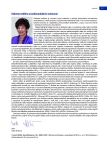Relationship of diabetes mellitus and aortic aneurysms
Authors:
Ľubomír Fľak; Juraj Maďarič
Authors‘ workplace:
Klinika kardiológie a angiológie, NÚSCH a. s. a LF SZU, Bratislava
Published in:
Forum Diab 2017; 6(3): 146-148
Category:
Topic
Overview
Diabetes mellitus (DM), especially type 2, has increasing incidence worldwide with unfavourable expectations to the future. This disease is one of the most important risk factors of cardiovascular disease, with their more complicated course and with more adverse prognosis. The interesting finding from last 20 years is, that this adverse association applies to coronary artery disease, cerebrovascular diseases and periphery artery disease, but not to aneurysmatic aortic (AA) disease. This article tries to summarize “up-to-date” data about the relationship between DM and AA. It brings the data about the prevalence, incidence, progression and rupture risk of AA in diabetics. There are also mentioned hypothesis about this inverse association and about the most appropriate way of management and treatment of AA in diabetics.
Key words:
aortic aneurysms, diabetes mellitus, invasive treatment of aortic aneurysms, risk of rupture
Sources
1. Low Wang CC, Hess CN, Hiatt WR et al. Clinical Update: cardiovascular disease in diabetes mellitus. Atherosclerotic cardiovascular disease and heart failure in type 2 diabetes mellitus–mechanisms, management, and clinical considerations. Circulation 2016; 133(24): 2459–2502. Dostupné z DOI: <http://dx.doi.org/10.1161/CIRCULATIONAHA.116.022194>.
2. Erbel R, Aboyans V, Boileau C et al. [ESC Committee for Practice Guidelines].2014 ESC Guidelines on the diagnosis and treatment of aortic diseases: Document covering acute and chronic aortic diseases of the thoracic and abdominal aorta of the adult. The Task Force for the Diagnosis and Treatment of Aortic Diseases of the European Society of Cardiology (ESC). Eur Heart J 2014; 35(41): 2873–2926. Dostupné z DOI: <http://dx.doi.org/10.1093/eurheartj/ehu281>. Erratum in Corrigendum to: 2014 ESC Guidelines on the diagnosis and treatment of aortic diseases. [Eur Heart J 2015].
3. Madaric J, Vulev I, Bartunek J et al. Frequency of abdominal aortic aneurysm in patients >60 years of age with coronary artery disease. Am J Cardiol 2005; 96(9): 1214–1216.
4. Ito S, Akutsu K, Tamori Y et al. Differences in atherosclerotic profiles between patients with thoracic and abdominal aortic aneurysms. Am J Cardiol 2008; 101(5): 696–699. Dostupné z DOI: <http://dx.doi.org/10.1016/j.amjcard.2007.10.039>.
5. Prakash SK, Pedroza C, Khalil YA et al. Diabetes and reduced risk for thoracic aortic aneurysms and dissections: a nationwide case-control study. J Am Heart Assoc 2012;1(2): pii: jah3-e000323. Dostupné z DOI: <http://dx.doi.org/10.1161/JAHA.111.000323>.
6. Jiménez-Trujillo I, González-Pascual M, Jiménez-García R et al. Type 2 Diabetes Mellitus and Thoracic Aortic Aneurysm and Dissection: An Observational Population-Based Study in Spain From 2001 to 2012. Medicine (Baltimomore) 2016; 95(18): e3618. Dostupné z DOI: <http://dx.doi.org/10.1097/MD.0000000000003618>.
7. De Rango P, Farchioni L, Fiorucci B et al. Diabetes and abdominal aortic aneurysms. Eur J Vasc Endovasc Surg 2014;47(3):243–261. Dostupné z DOI: <http://dx.doi.org/10.1016/j.ejvs.2013.12.007>.
8. Shirani S, Shakiba M, Soleymanzadeh M et al. Ultrasonographic Screening for Abdominal Aortic Aneurysms in Iranian Candidates for Coronary Artery Bypass Graft Surgery. Arch Iranian Med 2009; 12(4): 383–388.
9. Sweeting MJ, Thompson SG, Brown LC et al. [RESCAN Collaborators]. Meta-analysis of individual patient data to examine factors affecting growth and rupture of small abdominal aortic aneurysms. Br J Surg 2012; 99(5): 655–665. Dostupné z DOI: <http://dx.doi.org/10.1002/bjs.8707>.
10. Theivacumar NS, Stephenson MA, Mistry H et al. Diabetics are less likely to develop thoracic aortic dissection: a 10-year single-center analysis. Ann Vasc Surg 2014; 28(2): 427–432. Dostupné z DOI: <http://dx.doi.org/10.1016/j.avsg.2013.03.024>.
11. Wanhainen A, Bylund N, Björck M. Outcome after abdominal aortic aneurysm repair in Sweden 1994–2005. Br J Surg 2008; 95(5): 564–570. Dostupné z DOI: <http://dx.doi.org/10.1002/bjs.6109>.
12. Lopez-de-Andres A, Jimenez-Trujillo I, Jimenez-Garcia R et al. National trends in incidence and outcomes of abdominal aortic aneurysm among elderly type 2 diabetic and non-diabetic patients in Spain (2003–2012). Cardiovasc Diabetol 2015; 14:48. Dostupné z DOI: <http://dx.doi.org/10.1186/s12933–015–0216–1>. Erratum in – Erratum to: National trends in incidence and outcomes of abdominal aortic aneurysm among elderly type 2 diabetic and non-diabetic patients in Spain (2003–2012). [Cardiovasc Diabetol. 2016].
13. Gupta PK, Engelbert TL, Ramanan B et al. Postdischarge outcomes after endovascular abdominal aortic aneurysm repair. J Vasc Surg 2014; 59(4): 903–908. Dostupné z DOI: <http://dx.doi.org/10.1016/j.jvs.2013.10.057>.
14. Lawaetz Kristensen K, Dahl M, Rasmussen LM et al. Glycated Hemoglobin Is Associated With the Growth Rate of Abdominal Aortic Aneurysms. Arterioscler Thromb Vasc Biol 2017; 37(4):730–736. Dostupné z DOI: <http://dx.doi.org/10.1161/ATVBAHA.116.308874>.
15. Torsney E, Pirianov G, Cockerill GV. Diabetes as a negative risk factor for abdominal aortic aneurysm – does the disease aetiology or the treatment provide the mechanism of protection? Curr Vasc Pharmacol 2013; 11(3): 293–298.
16. Sidloff D, Choke E, Stather P et al. Mortality from thoracic aortic diseases and associations with cardiovascular risk factors. Circulation 2014; 130(25): 2287–2294. Dostupné z DOI: <http://dx.doi.org/10.1161/CIRCULATIONAHA.114.010890>.
Labels
Diabetology Endocrinology Internal medicineArticle was published in
Forum Diabetologicum

2017 Issue 3
Most read in this issue
- Rehabilitation in diabetic patients
- Management of cardiovascular risk in the light of current recommendations
- Diabetes mellitus and cerebrovascular diseases
- Fourier Study: Has it brought little or a lot of good? Or has it just failed to reach exaggerated expectations?
